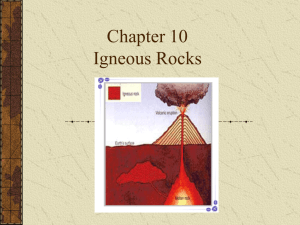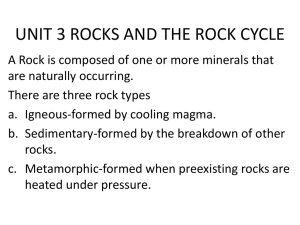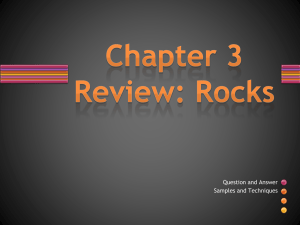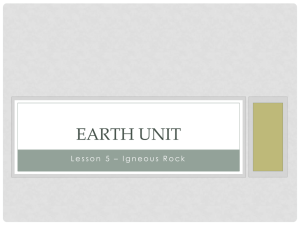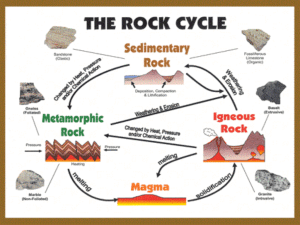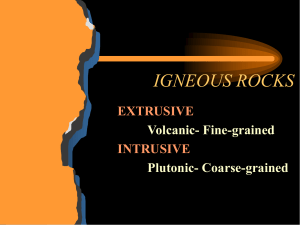IGNEOUS ROCKS & VOLCANISM - Missouri State University
advertisement
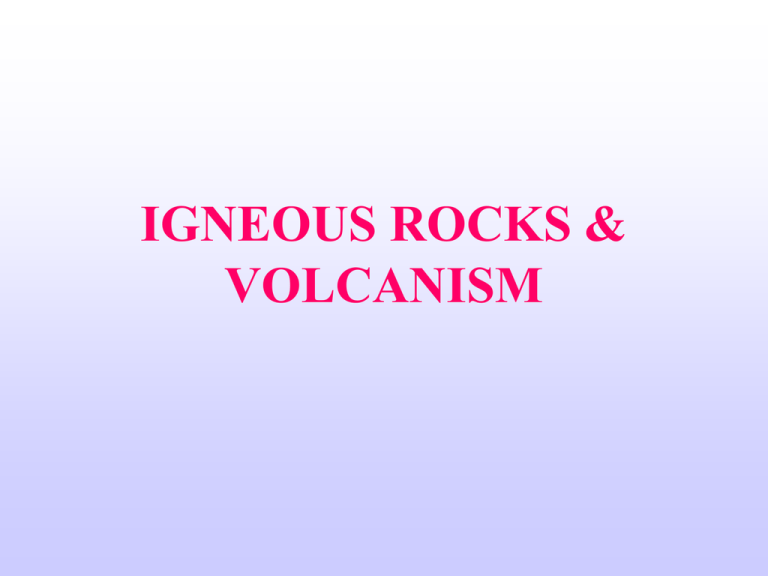
IGNEOUS ROCKS & VOLCANISM a rock is an aggregate of mineral(s) or mineral matter which occurs in massive deposits bedrock is a massive unbroken solid rock directly overlain by soil in many locations an outcrop is a massive unbroken solid rock exposed at the Earth’s surface IGNEOUS ROCK FAMILY • Definition of igneous rock • Origin of magma • convergent plate boundaries (subduction zones) • divergent plate boundaries (ridges or rifts) • isolated magma plumes (hot spots) IGNEOUS ROCK FAMILY • Assimilation • melting of other rock material incorporated into a magma causing original composition magma to change • an example is the mixing of magma originating in mantle with a different composition of continental crust as magma rises IGNEOUS ROCK FAMILY • Intrusive and extrusive as applied to magmas and igneous rocks • intrusive refers to any igneous activity below Earth’s surface • extrusive refers to any igneous activity at the Earth’s surface IGNEOUS ROCK FAMILY • Texture, mineral composition , and igneous rock names • texture • grain size of mineral fragments in rock and depends on the cooling rate of magma • smaller in rock if magma cools fast • larger in rock if magma cools slower IGNEOUS ROCK FAMILY • kinds of textures • phaneritic (coarse grained)--intrusive • aphanitic (fine grained)--extrusive • glassy--extrusive • vesicular (comprised of many holes called vesicles --extrusive • porphyritic--more than 1 size mineral fragment present-phenocrysts and matrix IGNEOUS ROCK FAMILY • pegmatitic--intrusive • pyroclastic--extrusive Igneous Rock Textures Phaneritic Aphanitic Igneous Rock Textures Glassy Vesicular Porphyritic Pegmatitic IGNEOUS ROCK FAMILY • mineral composition • igneous rocks are comprised of a combination of silicate minerals • Bowen’s mineral series • describes an orderly sequence of mineral formation from a cooling magma and explains specific mineral combinations in the rock • discontinuous and continuous series • hydrothermal solutions IGNEOUS ROCK FAMILY • magma composition • can change (1) as cooling progresses and minerals separate; (2) magma assimilation • igneous rock names • essential minerals • minerals in rock used to classify rock by name • accessory minerals • minerals not used to classify rock IGNEOUS ROCK FAMILY • felsic • rocks light in color and contain a lot of feldspar and quartz • mafic • rocks dark in color because they contain a lot of biotite, hornblende, or other dark minerals • ultramafic • rocks that contain augite and olivine • igneous rock chart Igneous Rock Classification Table Phaneritic Textured Igneous Rocks Granites Diorite Gabbro Dunite Aphanitic Textured Igneous Rocks Rhyolite Basalt Porphyritic Textured Igneous Rocks Granite Porphyry Rhyolite Porphyry Andesite Porphyry Glassy and Vesicular Textured Igneous Rocks Obsidian Pumice (2) Scoria IGNEOUS ROCK FAMILY • Igneous rock bodies • intrusive (plutons) • discordant-- bodies which cut across sedimentary rock contacts or boundaries • batholith--largest pluton body and irregular in shape--ore deposits like gold, silver, copper etc. are often associated with these Batholiths in Western USA IGNEOUS ROCK FAMILY • stock--smaller irregular shaped body with possible associated ore bodies • dike--very small tabular shaped body • concordant--do not cut across sedimentary rock boundaries • laccolith--large lens shaped body • sill-- a small tabular shaped body Igneous Rock Bodies (Plutons) IGNEOUS ROCK FAMILY • Important uses of igneous rocks • used as building materials and tombstones--this use is the same for all 3 families of rocks • pumice is used an an abrasive material VOLCANISM VOLCANISM • Some common terms • volcanism • the processes by which magma and/or gases or volatiles are transferred to the Earth’s surface • volcano • an elevated area or mountain formed from accumulations of lava and/or pyroclastic materials VOLCANISM • active, dormant, and extinct volcanoes and volcanic areas • active--eruption can occur in the near future--Mt. St. Helens and other Cascade mountains are examples • dormant--presently inactive but believed capable of future eruptions • extinct--expected not to erupt again • Origin and global distribution of volcanism • origin of volcanic materials VOLCANISM • global distribution • “Ring of Fire” or circum-Pacific region is the greatest concentration of volcanic activity on Earth • Mediterranean Region---2nd largest region of volcanoes on Earth Concentration of Volcanic areas on Earth VOLCANISM • Volcanic rocks, volatiles (gases and vapors), and manner of eruption • volcanic rocks • include all extrusive textured rocks and include basalt, andesite, rhyolite, pumice, scoria, tuff, obsidian and volcanic breccia • volatile emissions • steam (water vapor)--most abundant VOLCANISM • carbon dioxide is next abundant while sulfur dioxide, nitrogen, and sulfur trioxide are others • carbon dioxide additions into the atmosphere can add to the “Greenhouse Effect” and the others can contribute to acid rain formation • burning or decomposition of fossil fuels are synthetic contributions to the“Greenhouse Effect and acid rain VOLCANISM • manner of eruption (passive or explosive) • depends largely on viscosity of magma • viscosity depends on composition and temperature of the magma associated with the eruption--the higher the silica content or the cooler the magma, the more explosive the eruption, and vice versa • most ocean basin eruptions are passive while most continental are explosive--why??? Volcanic Eruptions on Continents VOLCANISM • Major categories of volcanic deposits (Classification of volcanoes) • deposits are comprised of lava flows and/or pyroclastics • shield type---broad with gentle slopes • thick deposit of basaltic lava flows with little or no pyroclastic materials • associated with ocean basin eruptions • Hawaiian shield is about 28,000 feet thick with pimple-like islands Shield Type of Volcanic Deposit Shield Type of Volcanic Deposit-Kilauea– Hawaiian Islands Earth’s most active and Mauna Loa— Earth’s largest volcano Shield Type of Volcanic Deposit--Hawaiian Islands VOLCANISM • cinder cone or scoria cone • small deposit of pyroclastic or ejected materials • steep slopes and less than 1000 feet tall • represents last stage (cooler) of basaltic or less commonly andesite eruptions • example is Paricutin, Mexico which erupted in 1943 and grew 120 feet tall the first day Cinder Cone Type of Volcanic Deposit Cinder Cones in Arizona VOLCANISM • composite or stratovolcano • very tall deposit of alternating lava flow and pyroclastic deposits • comprised of andesite or rhyolite, occur on the continents and are explosive • examples include: Mt. Vesuvius, Mt. Fujiyama, Mt. Kilamanjaro and mountains in the Cascades including Mt. St. Helens Stratovolcano Type of Volcanic Deposit VOLCANISM Famous Composite Volcanoes Mt. Fuji Mt. Shasta Mt. Kilimanjaro volcanic dome solidified lava, hundreds of meters high volcanic ash mixed with rock fragments viscous felsic or intermediate magma piled up around a vent found in composite volcanoes VOLCANISM • Eruptions with special volatile emissions • strombolian type • incandescent cloud is stable over vent and reflects light from magma • Mt.Stromboli is best example and called “Lighthouse of the Mediterranean” VOLCANISM Mount Stromboli VOLCANISM • Nuee Ardentes (fiery or glowing cloud) type---pyroclastic flow • a very hot cloud of volatiles and ash • Mt. Pelee on Martinique emitted a 700 degree (C) cloud and killed 30,000 people in a few minutes in St. Pierre VOLCANISM pyroclastic flow VOLCANISM St. Pierre after Mount Pelee’s eruption Art 06.08a1 VOLCANISM Artist’s conception of Vesuvius’ eruption in A.D. 79 over Pompeii and Herculaneum VOLCANISM Lake Nios type volcanic carbon dioxide trapped in the subsurface was emitted and killed 1746 villagers in Cameroon, Africa in 1986 Special features and benefits associated with volcanism special features continental flows Continental Lava Flows in Western USA VOLCANISM • ocean basin flows--associated with the shield type deposit • pahoehoe--ropy surface lava • aa--blocky surface lava • lava tubes or tunnels • volcanic neck and radiating dikes Volcanic neck and Radiating Dikes at Shiprock, New Mexico VOLCANISM • caldera • a crater caused by the collapse of a volcanic cone • Crater Lake, Oregon is the best terrestrial example • Crater Lake is 5 miles in diameter Formation of a Caldera Crater Lake, Oregon Could the Yellowstone Caldera Cause a Future Disaster? Yellowstone is one of the world’s largest active volcanic areas. Abundant geysers, hot springs, and other hydrothermal activity are leftovers from its recent volcanic past. It erupted about 600,000 years ago and is about time again. Olympus Mons, Mars---Shield Type with Caldera formally known as Nix Olympica, it rises about 13 miles high, or 3 times higher than Mtn. Everest and covers an area equal to Arizona. It is the largest volcano in the solar system— it has 6 calderas— VOLCANISM • Benefits related to volcanism and igneous activity • fertile soils formed from weathering of igneous rocks • magma in contact with or in the vicinity of groundwater produces steam which is a source of geothermal energy VOLCANISM Geothermal Energy From Hydrothermal Ocean Vents CLICK HERE subsurface volcanic water mined on extra-terrestrial bodies may affect colonization of those bodies VOLCANISM • Mass wasting associated with volcanism • severe damage can result from mudflows on the sides of volcanoes---these flows are called lahars which can form when highly unstable layers of volcanic ash and debris are saturated with water VOLCANISM A house moved by a lahar VOLCANISM Lahar mudflow VOLCANISM • Prediction of volcanic eruptions • the increase in the number and magnitude of earthquakes associated with volcanic activity favors volcanic activity sooner • the magnitude of bulging of Earth’s surface can be used an eruption predictor • tilt meters and laser mirrors can be used to measure the magnitude of bulge VOLCANISM • Volcanism in the solar system • on the moon • presence of light colored and basaltic lava flows • Mars • Olympus Mons and other caldera, and is 13 miles high and its base covers an area the size of Arizona—good extraterrestrial example of a shield volcano VOLCANISM • Io, a moon of Jupiter • only other place where volcanic activity was actually observed happening


